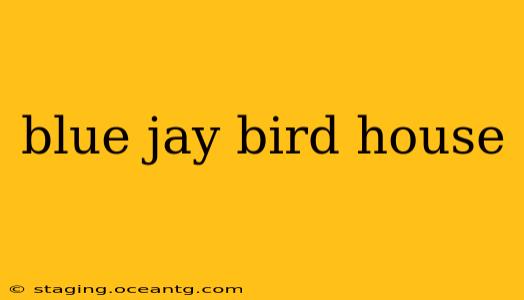Blue Jays, with their vibrant plumage and boisterous calls, are a captivating addition to any backyard. Attracting these intelligent birds often involves providing suitable nesting sites. While they can utilize natural cavities, a well-designed blue jay birdhouse can significantly increase your chances of hosting a pair. This guide delves into the specifics of constructing and placing the ideal blue jay birdhouse, ensuring a successful nesting season.
What Size Birdhouse Do Blue Jays Need?
Blue Jays are larger than many other North American songbirds, requiring a significantly bigger house. A suitable birdhouse should have a floor diameter of at least 6 inches and a height of at least 8 inches. Smaller dimensions will likely deter blue jays from using the house. The entrance hole should be approximately 2.5-3 inches in diameter. Remember, a cramped space will discourage nesting, and a too-large entrance may invite unwanted guests.
What Kind of Wood is Best for a Blue Jay Birdhouse?
Durability is key when choosing wood for your blue jay birdhouse. Untreated cedar, redwood, or pine are excellent options due to their resistance to rot and decay. Avoid using treated lumber, as the chemicals can be harmful to the birds. The wood should be strong enough to withstand the elements and potential predators.
How High Should a Blue Jay Birdhouse Be?
Blue Jays prefer to nest in elevated locations, often in tall trees or on sturdy branches. Aim to mount your birdhouse at a height of 6 to 15 feet above the ground. This height offers protection from ground predators like raccoons and cats, while still allowing easy access for the birds.
Where Should I Place a Blue Jay Birdhouse?
Beyond height, the placement of your birdhouse is critical. Consider these factors:
- Protection from the elements: The birdhouse should be positioned to avoid direct exposure to harsh winds and heavy rain. A slightly overhanging branch can offer additional protection.
- Concealment: While blue jays are relatively bold, they prefer some degree of privacy during nesting. Locate the birdhouse amidst foliage for concealment from predators and curious eyes.
- Accessibility: While maintaining a safe distance from predators, ensure the birdhouse is accessible for cleaning and monitoring.
What Materials Should I Use to Build a Blue Jay Birdhouse?
Beyond the wood, you'll need:
- Screws: Use exterior-grade screws to ensure the birdhouse remains securely assembled.
- Waterproof sealant: Apply a sealant to all joints to prevent water damage and maintain the house's longevity.
- Ventilation: Ensure adequate ventilation to prevent mold and mildew buildup. Small holes drilled near the top can improve airflow.
- Drainage: Include a small drainage hole in the bottom to prevent water accumulation.
How Do I Clean a Blue Jay Birdhouse?
Cleaning is crucial to prevent the spread of parasites and diseases. After the nesting season, thoroughly clean the birdhouse by scrubbing it with a mild soap solution and water. Allow it to dry completely before storing it for the winter.
When Should I Put Up a Blue Jay Birdhouse?
Ideally, you should put up your blue jay birdhouse in the late winter or early spring, before the birds begin their nesting season. This will give them ample time to discover and claim it as their nesting site.
Do Blue Jays Reuse Birdhouses?
While blue jays may reuse a birdhouse, they are not guaranteed to do so. Providing a clean, well-maintained, and secure nesting site significantly improves your chances of attracting them year after year.
By following these guidelines, you'll significantly increase your chances of successfully attracting blue jays to your backyard and witnessing the wonder of their nesting habits. Remember, providing a safe and comfortable environment is key to their successful breeding.
